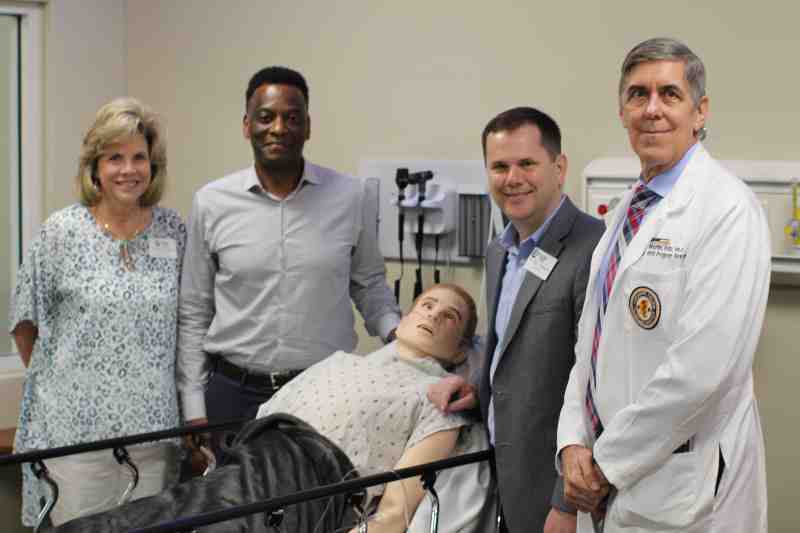State-of-the-Art Simulation Center at MC Trains PA Students to become Effective Practitioners

A trio of physician assistant students at Mississippi College was conducting a routine evaluation of a patient who had suffered an anterior wall heart attack earlier in the day when his condition changed dramatically.
He began to complain of dizziness and nausea. His breathing became erratic. His heartbeat escalated rapidly.
Then he became nonresponsive.
Checking the heart monitor, the PA students immediately recognized an irregular and deadly rhythm called ventricular fibrillation and sprang into action. One began doing cardiopulmonary resuscitation on the patient while another called for an emergency code team for help. A third comforted a distraught family member while leading him outside the room.
Within seconds, members of the code team arrived, working seamlessly to assist the patient. The team leader gave clear instructions to each of the responders, who continued CPR and administered medication to stimulate the patient’s heart. The team followed established resuscitation protocols and deployed a defibrillator to deliver an electric shock to the patient’s heart.
After two shocks, the patient’s heartbeat returned, and the code team gave him further medications to stabilize his now normal heart rhythm and ordered appropriate lab tests.
This high-stakes scenario played out in front of a panel of Mississippi College administrators as part of an adrenaline-heightening demonstration of the brand-new MC Physician Assistant Program Medical Simulation Center on the first floor of the Baptist Healthplex in Clinton on April 22.
It will be repeated time and again – with many different variations and various outcomes – with this particular patient, a state-of-the-art Laerdal SimMan 3G Plus advanced patient simulator, nicknamed “Billy Ruben.”
Faculty instructors and a simulation technician in a darkened control room adjacent to the center’s main area manipulate the medical mannequin, which has an extraordinary range of capabilities, according to Dr. Steve Martin, professor, program director, and department chair of Physician Assistant Studies at MC.
“It has a real pulse, you can take a blood pressure, you can give it drugs, and it reacts appropriately to the drug given,” Martin said. “You can do CPR, and it will measure the effectiveness of that CPR by rate and by the depth of compressions. You can perform a needle chest decompression. Its eyes constrict when you shine a light in them. It blinks. It can create a simulated foreign body in the airway or airway swelling. It gets cyanotic. It sweats. You can start IVs.
“There’s a whole host of activities you can perform on this one mannequin.”
The mannequin serves as the centerpiece of the medical simulation center that will help prepare physician assistant students at MC for patient encounters they will face in real life.
“It brings to life the skills and medical knowledge base the students are learning,” Martin said. “It helps provide a practical application of those skills in as real an environment as possible before they go out on clinical rotations in hospitals, clinics, and physician offices.
“Even after they go out on rotations, it allows them to come back and refresh and rehearse those skills over and over again.”
Cassidy McKinney of Minden, Louisiana, a first-year student in the didactic phase of the PA program at MC, participated in the exercise. She said the center will be an extraordinary asset to the program because it will help produce higher-quality physician assistants for the medical workforce.
“My heart is still pounding from doing the simulation, because it felt very real,” McKinney said. “The biggest thing is learning how to modulate your own emotions and your stress in the moment. It’s valuable to know how you’re going to react when an emergency happens, and how you can stay calm. Today, I was on compressions, but out in the hospital, I need to be able to do airway, compressions, medications, and run the defibrillator. They teach us different parts, so we can use the simulation center to learn each piece.
“I am extremely grateful that we have a center where we can practice, because I can only imagine how nerve-racking it would be to do this out in a hospital with a real patient whenever we haven’t truly run through all the motions.”
Every scenario includes three phases. During the pre-brief, PA students learn about the clinical situation they will encounter and how they will be individually assessed. The scenario itself can be altered in real-time, so students can react to the situation and employ their critical thinking skills. But the debrief is where most of the instruction takes place, according to Katryna Horton, assistant professor in the Physician Assistant Studies Department at MC.
“We can record the simulation and play it back for the students so they can watch themselves,” said Horton, who helped integrate the center into the PA program’s curriculum. “Things they thought might have gone well maybe don’t look as good when played back. They can talk about how they felt they responded during the simulation, whether they could have done something better or worse.
“That solidifies the learning experience, so they don’t just mess up something and walk away thinking, ‘That went terribly.’ They can talk through it, which helps them process what happened and retain it for further use.”
While the mannequin is a centerpiece, it is by no means the only simulation aid in the center. Also available is a surgical sink, modern “IV arms,” and a host of tools to help train students to perform clinical skills they will use as practicing PAs.
“In particular, we use these aids before the students go out on rotations to refresh the skills that may have atrophied a little over time,” Martin said. “For instance, right before they go on emergency medicine and surgery rotations, we refresh them in suturing and other critical skills they’ll use on real patients.
“We teach them about gowning and gloving in preparation before surgery. We train them so they’re ready to go straight into the operating room and work and learn in that environment.”
Horton said students always register a positive experience whenever they are assigned to participate in a medical simulation in the new center.
“This is a huge opportunity for our students, and it’s a great attractant to future applicants,” she said. “Being able to do a lot of hands-on learning is the direction a lot of medical education is going. Students aren’t as enthralled by the ‘Death by PowerPoint’ model of instruction. Being able to come into this facility, see the mannequin and all the things it can do, can augment their learning in a significant way.
“It’s a great opportunity for future applicants to come here and see that we are keeping up with the times and offering the best training facility to them.”
The demonstration was also witnessed by Rebecca K. Cockrell, director of the Mississippi Academy for Simulation Training at the University of Mississippi Medical Center and director of the Ball Simulation Center at Hinds Community College. Cockrell collaborated with members of the PA program to help optimize the MC simulation center’s setup.
“We found in our training through Ms. Cockrell that the world of simulation is very unique in that we are all well suited to help each other,” Martin said. “We work collaboratively, share ideas freely, and share cases freely.
“There’s a huge amount of resources available, and it’s helpful to us as a new center to have access to those readily available sources that get us up to speed faster.”
That collaboration extends across the MC campus, too.
“One of our strengths at Mississippi College is we have a positive spirit of collaboration with our coworkers,” Martin said. “That especially includes our School of Nursing. They’ve been very gracious in incorporating us in their simulations, such as in their birthing model. They have simulated hospital rooms and other resources. They’ve had our students over and have taught them directly. We’d like to be able to do the same.
“We’d like to have collaborative events with PA students and nursing students working side-by-side in this simulation center, where they’re free to learn and make mistakes, but not feel bad. This gives them the opportunity to learn these critical skills and have them work together as a team. We’re happy about that.”
Although the center has only recently opened for PA students, Martin said his team is already eyeing expansion.
“We have enough room for a second bay, so at some point, we’d like to add another type of mannequin or some other aid,” he said. “That’s why we call this a center, because the simulation centers on a number of modalities to help train our students.
“Our dream is that someday, we will have a health science center where we can put all of the health science groups together in one building and work even more easily together.”
Sign-up For Our Newsletter
Get the latest news about Mississippi College delivered right to your inbox by subscribing to the Along College Street e-newsletter.


